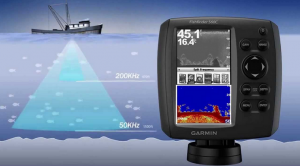
There are a lot of choices when it comes to fish finders today. How do you know which one to get? It comes down to understanding the differences between the different types available on the market. This is of course in conjunction with quality on each band.
The measurements of reflected pulses are displayed on fish finders, thereby allowing the fishermen to interpret data and to locate underwater debris, fish and the water depth.
Working of a fish finder
Fish finders are an important tool for anglers, whether fishing tournaments or sport. These instruments send a sonar signal beneath the water, which then bounces back off fish and other objects present under the surface. This signal that comes back will alert and notify whether a school of fish is present, the current depth and other information, even water tempture on some models.
The best fish finders come full of latest technologies and patterns that include high definition color screens, with features like sonar imaging and customized mapping.
Portable fish finders are also available that have GPS facilities as well.
Choosing the best fish finder
To choose a suitable fish finder, one needs to consider the unit type and specifications like:
- Whether it needs GPS and a boat wide network
- The size of the footprint of a fish finder
- The image size of the display
- Power requirement needed for transmission
- Best frequencies that will work in the environment like coastal, inland or deep-water.
Photo by: marineelectronicshq.com
Make a choice
Mostly three fish finder choices are there, which include:
- Standalone fish finder
- Combo fish finder
- Network fish finder
Below mentioned are some of the reasons to choose among them:
- Standalone fish finder- As the name suggests, it performs no other function apart from its major task. It helps us to see what is there below the surface. These dedicated fish finders give the best performance and biggest display for the least costal environment. These are preferred when the size of the boat is small or particularly for fishing small inland lakes on a limited budget and lower costs.
- Combination fish finder/chart plotter- In the case of a middle sized boat, combo units are the best options to choose from. These include a combo of GPS for navigation, a big split screen etc. A chart plotter can be turned into combo units with the introduction of transducer in between them.
- Networked system- All the major suppliers supply fully networked system that supports a wide range of information sources that involves radar, raster, video, vector charts and XM satellite radio.
Most of them allow Wi-Fi/Bluetooth and can even be controlled from iPhone or android phones. They are greatly used in case of a medium sized or big vessels having capabilities that increase every year.
To select power and frequency range
The power or the strength of a fish finder is expressed in root mean square. Power is directly proportional to the quality that can be seen in slit-laden water that helps to see up to greater depths. A 500 watt fish finder comprises of a plenty of power for most of the coastal applications.
Fish finders can be operated using a single frequency, dual frequencies or a multi frequency transducer system.
In general, a higher frequency gives the finest resolution with the least background noise and the best view from a faster moving boat.
Style and Shape of a fish finder
Fish finders are available in various sizes and shapes, such as:
- In-hull: These types of shapes are glued inside of the hull through silicone.
- Trolling motor: Permanently installed inside of trolling motor are present in of the most popular fish finders.
- Thu-hull: It provides the best quality signals, but most of us face challenges to install this style. It consists of temperature and depth sensors along with a speed paddle wheel.
I hope the above tips helps you in selecting the fish finder that works perfect for you.